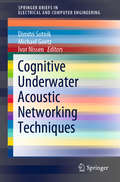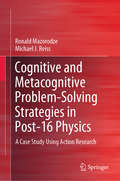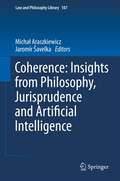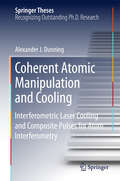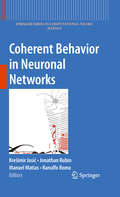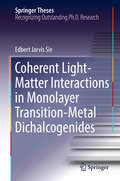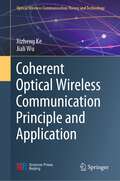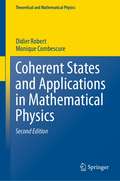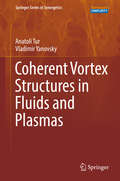- Table View
- List View
Cognitive Underwater Acoustic Networking Techniques (SpringerBriefs in Electrical and Computer Engineering)
by Michael Goetz Ivor Nissen Dimitri SotnikThis book summarizes the latest research on cognitive network-layer methods and smart adaptive physical-layer methods in underwater networks. Underwater communication requires extendable and delay-tolerant underwater acoustic networks capable of supporting multiple frequency bands, data rates and transmission ranges. The book also discusses a suitable foreground communication stack for mixed mobile/static networks, a technology that requires adaptive physical layer waveforms and cognitive network strategies with underlying cooperative and non-cooperative robust processes. The goal is to arrive at a universally applicable standard in the area of Underwater Internet-of-Things [ISO/IEC 30140, 30142, 30143].
Cognitive Wireless Networks (SpringerBriefs in Electrical and Computer Engineering)
by Ping Zhang Zhiyong Feng Qixun ZhangThis brief examines the current research in cognitive wireless networks (CWNs). Along with a review of challenges in CWNs, this brief presents novel theoretical studies and architecture models for CWNs, advances in the cognitive information awareness and delivery, and intelligent resource management technologies. The brief presents the motivations and concepts of CWNs, including theoretical studies of temporal and geographic distribution entropy as well as cognitive information metrics. A new architecture model of CWNs is proposed with theoretical, functional and deployment architectures supporting cognitive information flow and resource flow. Key technologies are identified to achieve the efficient cognitive information awareness and delivery. The brief concludes by validating the effectiveness of proposed theories and technologies using the CWNs testbed and discussing the importance of standardization practices. The context and analysis provided by this text are ideal for researchers and practitioners interested in wireless networks and cognitive information. Cognitive Wireless Networks is also valuable for advanced-level students studying resource management and networking.
Cognitive and Affective Aspects in Science Education Research: Selected Papers from the ESERA 2015 Conference (Contributions from Science Education Research #3)
by Kaisa Hahl Kalle Juuti Jarkko Lampiselkä Anna Uitto Jari LavonenThis edited volume brings forth intriguing, novel and innovative research in the field of science education. The chapters in the book deal with a wide variety of topics and research approaches, conducted in various contexts and settings, all adding a strong contribution to knowledge on science teaching and learning. The book is comprised of selected high-quality studies that were presented at the 11th European Science Education Research Association (ESERA) Conference, held in Helsinki, Finland from 31 August to 4 September, 2015. The ESERA science education research community consists of professionals with diverse disciplinary backgrounds from natural sciences to social sciences. This diversity provides a rich understanding of cognitive and affective aspects of science teaching and learning in this volume. The studies in this book will invoke discussion and ignite further interest in finding new ways of doing and researching science education for the future and looking for international partners for both science education and science education research. The twenty-five chapters showcase current orientations of research in science education and are of interest to science teachers, teacher educators and science education researchers around the world with a commitment to evidence-based and forward-looking science teaching and learning.
Cognitive and Metacognitive Problem-Solving Strategies in Post-16 Physics: A Case Study Using Action Research (SpringerBriefs in Education)
by Michael J. Reiss Ronald MazorodzeThis book reports on a study on physics problem solving in real classrooms situations.Problem solving plays a pivotal role in the physics curriculum at all levels. However, physics students’ performance in problem solving all too often remains limited to basic routine problems, with evidence of poor performance in solving problems that go beyond equation retrieval and substitution. Adopting an action research methodology, the study bridges the `research-practical divide´ by explicitly teaching physics problem-solving strategies through collaborative group problem-solving sessions embedded within the curriculum. Data were collected using external assessments and video recordings of individual and collaborative group problem-solving sessions by 16-18 year-olds. The analysis revealed a positive shift in the students’ problem-solving patterns, both at group and individual level. Students demonstrated a deliberate, well-planned deployment of the taught strategies. The marked positive shifts in collaborative competences, cognitive competences, metacognitive processing and increased self-efficacy are positively correlated with attainment in problem solving in physics. However, this shift proved to be due to different mechanisms triggered in the different students.
Cognitive and Neural Foundations of Chinese Reading: From Learning to Advanced Processing and Beyond (Chinese Language Learning Sciences)
by Denise Hsien WuThis book provides a comprehensive and concise introduction of experiments on contemporary issues of language processing and the brain. It covers a wide range of neurolinguistic and neuroscience topics, including but not limited to word recognition, reading acquisition and dyslexia (in typically developed children, foreign language learners, and deaf people), comprehension of sentences and fictional narratives, the interplay of language processing/acquisition with other cognitive domains, and aging of language comprehension and Chinese reading. This book showcases the significance of empirical studies on language and cognitive processing, particularly those emerging from the Taiwan research community, to illuminate the intricate nature of the language faculty enabled by the sophisticated computations of the brain. This book informs readers of crucial issues in the neurolinguistic literature and advances in neuroimaging technology and provides perspectives inspired by evolution and neuroscience.
Cognitive-Behavioral Therapy with Adults
by Stefan G. Hofmann Mark A. ReineckeCognitive-behavioural therapy has developed hugely over the past 30 years and is the branch of psychotherapy which has most successfully transferred into the mainstream of treating mental health problems. In this volume, readers will be provided with an integrated, systematic approach for conceptualizing and treating disorders commonly encountered in clinical practice. A strong emphasis is placed on empirically supported approaches to assessment and intervention while offering readers hands-on recommendations for treating common mental disorders, grounded in evidence-based medicine. Practical chapters written by a variety of international experts include numerous case studies demonstrating the specific techniques and addressing common problems encountered and how to overcome them. Cognitive-behavioural Therapy with Adults is an essential guide for practising clinicians and students of cognitive-behavioural therapy as well as educated consumers and those interested in psychotherapy for common mental disorders.
Cognitive-Behavioral Therapy, Mindfulness, and Hypnosis for Smoking Cessation: A Scientifically Informed Intervention
by Steven Jay Lynn Joseph P. GreenCognitive-Behavioral Therapy, Mindfulness, and Hypnosis for Smoking Cessation: A Scientifically Informed Intervention presents a comprehensive program developed by noted experts to help smokers achieve their goal of life-long abstinence from smoking. This brief, cost-effective intervention, called The Winning Edge, incorporates state-of-the-science advances and best clinical practices in the treatment of tobacco addiction and offers participants a unique blend of strategies based on cognitive-behavioral, mindfulness, and hypnotic approaches to achieve smoking cessation. This valuable treatment guide, developed and refined over the past 30 years, provides all of the information necessary for health care providers to implement the program on a group or individual basis. <p><p> This important resource: <p><p> Provides a detailed, step-by-step guide to conducting the program, with scripts for providers and handouts for participants Explains the scientific basis for the many strategies of cognitive, behavioral, and affective change in The Winning Edge program Contains information for treatment providers on frequently asked questions, adapting and tailoring the program to the needs of participants, and overcoming challenges, ambivalence, and resistance to stop smoking <p><p>Written for a wide audience of mental health professionals, Cognitive-Behavioral Therapy, Mindfulness, and Hypnosis for Smoking Cessation: A Scientifically Informed Intervention offers a comprehensive, science-based approach to help participants achieve their goal of a smoke-free life.
Cognizance of Schizophrenia:: A Profound Insight into the Psyche
by Indranath ChatterjeeThis book provides the reader with a thorough understanding of schizophrenia as a complex brain disorder by explaining the various aspects investigated for its cognizance from epigenetics to chemistry and physics to computational approaches. The book covers the key notions of schizophrenia from a variety of facets such as neurogenetics, neurochemistry, neuropharmacology, neurobiology, psychotherapy, psychiatric treatment, cognitive studies, behavioral and societal studies, and computational neurosciences. Individual chapters are focused on crucial topics such as cognitive-behavioral therapy, brain functioning, computational neuroscience, neuro-imaging, and many more. This book explains each section and chapter with utmost clarity to maintain comprehensiveness for every kind of reader. This book covers various classical as well as recent topics from basic to advance level knowledge regarding schizophrenia. The book's contributions regarding its inclusivity of topics, comprehensiveness of language, diversity in knowledge, and focus on the subject will attract all kinds of readers. It can be considered a single comprehensive handy reference book for beginners, including medical students, neuroscientists, researchers, clinicians, and medical practitioners. Cognizance of Schizophrenia will be an invaluable asset for all who are involved in neuroscience research or clinical studies.
Coherence in Thought and Action
by Paul ThagardThis book is an essay on how people make sense of each other and the world they live in. Making sense is the activity of fitting something puzzling into a coherent pattern of mental representations that include concepts, beliefs, goals, and actions. Paul Thagard proposes a general theory of coherence as the satisfaction of multiple interacting constraints, and discusses the theory's numerous psychological and philosophical applications. Much of human cognition can be understood in terms of coherence as constraint satisfaction, and many of the central problems of philosophy can be given coherence-based solutions. Thagard shows how coherence can help to unify psychology and philosophy, particularly when addressing questions of epistemology, metaphysics, ethics, politics, and aesthetics. He also shows how coherence can integrate cognition and emotion.
Coherence: Insights From Philosophy, Jurisprudence And Artificial Intelligence (Law and Philosophy Library #107)
by Michał Araszkiewicz Jaromír ŠavelkaThis book is a thorough treatise concerned with coherence and its significance in legal reasoning. The individual chapters present the topic from the general philosophical perspective, the perspective of legal-theory as well as the viewpoint of cognitive sciences and the research on artificial intelligence and law. As it has turned out the interchange of knowledge among these disciplines is very fruitful for each of them, providing mutual inspiration and increasing understanding of a given topic. This book is a unique resource for anyone interested in the concept of coherence and the role it plays in reasoning. As this book captures important contemporary issues concerning the ongoing discussion on coherence and law, those interested in legal reasoning should find it particularly helpful. By presenting such a broad scope of views and methods on approaching the issue of coherence we hope to promote the general interest in the topic as well as the academic research that centers around coherence and law.
Coherent Atomic Manipulation and Cooling: Interferometric Laser Cooling and Composite Pulses for Atom Interferometry (Springer Theses)
by Alexander J. DunningThis work unites the concepts of laser cooling and matter-wave interferometry to develop an interferometric laser cooling technique in an experimental system of cold rubidium atoms. Serving as an introduction to graduate level coherent optical atomic manipulation, the thesis describes the theory of stimulated Raman transitions and atom interferometry, along with the experimental methods for preparing and manipulating cold atoms, before building on these foundations to explore tailored optical pulse sequences and novel atomic cooling techniques. Interferometric cooling, originally proposed by Weitz and Hänsch in 2000, is based upon the coherent broadband laser pulses of Ramsey interferometry and in principle allows laser cooling of atomic and molecular species outside the scope of traditional Doppler laser cooling. On the path toward cooling, composite pulses - quantum error correction methods, developed by chemists to mitigate the effects of in homogeneities in NMR spectroscopy - are investigated with a view to improving the performance of atom interferometers.
Coherent Behavior in Neuronal Networks (Springer Series in Computational Neuroscience #3)
by Jonathan Rubin Manuel Matias Ranulfo Romo Krešimir JosicRecent experimental research advances have led to increasingly detailed descriptions of how networks of interacting neurons process information. With these developments, it has become clear that dynamic network behaviors underlie information processing, and that the observed activity patterns cannot be fully explained by simple concepts such as synchrony and phase locking. These new insights raise significant challenges and offer exciting opportunities for experimental and theoretical neuroscientists. Coherent Behavior in Neuronal Networks features a review of recent research in this area from some of the world's foremost experts on systems neuroscience. The book presents novel methodologies and interdisciplinary perspectives, and will serve as an invaluable resource to the research community. Highlights include the results of interdisciplinary collaborations and approaches as well as topics, such as the interplay of intrinsic and synaptic dynamics in producing coherent neuronal network activity and the roles of globally coherent rhythms and oscillations in the coordination of distributed processing, that are of significant research interest but have been underrepresented in the review literature. With its cutting-edge mathematical, statistical, and computational techniques, this volume will be of interest to all researchers and students in the field of systems neuroscience.
Coherent Control of Nuclei and X-Rays (Springer Theses)
by Wen-Te LiaoNovel coherent light sources such as x-ray free-electron lasers open exciting prospects for the interaction of light with nuclei. The thesis "Coherent Control of Nuclei and X-rays" covers this still-developing field and proposes, in a daring attempt to revolutionize nuclear physics, three innovative schemes for taming nuclei using coherent effects. The theoretical explorations, which address control of nuclear quantum states, a nuclear memory for single photons in future photonic circuits, and optimized concepts for a nuclear clock, make use of new approaches at the borderline between nuclear physics and quantum dynamics. The result is a well written work, impressive in its stimulating style and promising ideas.
Coherent Light-Matter Interactions in Monolayer Transition-Metal Dichalcogenides (Springer Theses)
by Edbert Jarvis SieThis thesis presents optical methods to split the energy levels of electronic valleys in transition-metal dichalcogenides (TMDs) by means of coherent light-matter interactions. The electronic valleys found in monolayer TMDs such as MoS2, WS2, and WSe2 are among the many novel properties exhibited by semiconductors when thinned down to a few atomic layers, and have have been proposed as a new way to carry information in next generation devices (so-called valleytronics). These valleys are, however, normally locked in the same energy level, which limits their potential use for applications. The author describes experiments performed with a pump-probe technique using transient absorption spectroscopy on MoS2 and WS2. It is demonstrated that hybridizing the electronic valleys with light allows one to optically tune their energy levels in a controllable valley-selective manner. In particular, by using off-resonance circularly polarized light at small detuning, one can tune the energy level of one valley through the optical Stark effect. Also presented within are observations, at larger detuning, of a separate contribution from the so-called Bloch--Siegert effect, a delicate phenomenon that has eluded direct observation in solids. The two effects obey opposite selection rules, enabling one to separate the two effects at two different valleys.
Coherent Multidimensional Spectroscopy (Springer Series in Optical Sciences #226)
by Minhaeng ChoThis book will fulfill the needs of time-domain spectroscopists who wish to deepen their understanding of both the theoretical and experimental features of this cutting-edge spectroscopy technique. Coherent Multidimensional Spectroscopy (CMDS) is a state-of-the-art technique with applications in a variety of subjects like chemistry, molecular physics, biochemistry, biophysics, and material science. Due to dramatic advancements of ultrafast laser technologies, diverse multidimensional spectroscopic methods utilizing combinations of THz, IR, visible, UV, and X-ray radiation sources have been developed and used to study real time dynamics of small molecules in solutions, proteins and nucleic acids in condensed phases and membranes, single and multiple excitons in functional materials like semiconductors, quantum dots, and solar cells, photo-excited states in light-harvesting complexes, ions in battery electrolytes, electronic and conformational changes in charge or proton transfer systems, and excess electrons and protons in water and biological systems.
Coherent Optical Wireless Communication Principle and Application (Optical Wireless Communication Theory and Technology)
by Xizheng Ke Jiali WuThis book presents the key technologies of coherent optical wireless communication, covers topics such as beam coupling, signal optical polarization control and distorted wavefront correction. It discusses the principle of coherent optical communication and heterodyne detection conditions. In this book, the array coupling receiving technology and large aperture coupling technology are introduced to realize the spatial optical fiber coupling; simulated annealing algorithm, particle swarm optimization algorithm and SPO algorithm are used to control the polarization state of the signal beam; and the correction of distorted wavefront of the signal beam by adaptive optics technology and wavefront sensorless adaptive optics technology are analyzed, and the influence of beam mode on coherent detection performance is elaborated. Both theoretical deduction and experimental results are included in this book, which can help readers further understand the theoretical knowledge.
Coherent Raman Scattering Microscopy (Series in Cellular and Clinical Imaging)
by Ji-Xin Cheng Xiaoliang Sunney XieThe First Book on CRS MicroscopyCompared to conventional Raman microscopy, coherent Raman scattering (CRS) allows label-free imaging of living cells and tissues at video rate by enhancing the weak Raman signal through nonlinear excitation. Edited by pioneers in the field and with contributions from a distinguished team of experts, Coherent Raman Sc
Coherent States and Their Applications: A Contemporary Panorama (Springer Proceedings in Physics #205)
by Fabio Bagarello Jean-Pierre Gazeau Jean-Pierre AntoineCoherent states (CS) were originally introduced in 1926 by Schrödinger and rediscovered in the early 1960s in the context of laser physics. Since then, they have evolved into an extremely rich domain that pervades virtually every corner of physics, and have also given rise to a range of research topics in mathematics.The purpose of the 2016 CIRM conference was to bring together leading experts in the field with scientists interested in related topics, to jointly investigate their applications in physics, their various mathematical properties, and their generalizations in many directions. Instead of traditional proceedings, this book presents sixteen longer review-type contributions, which are the outcome of a collaborative effort by many conference participants, subsequently reviewed by independent experts.The book aptly illustrates the diversity of CS aspects, from purely mathematical topics to physical applications, including quantum gravity.
Coherent States and Applications in Mathematical Physics (Theoretical and Mathematical Physics)
by Didier Robert Monique CombescureThis book presents the various types of coherent states introduced and studied in the physics and mathematics literature and describes their properties together with application to quantum physics problems. It is intended to serve as a compendium on coherent states and their applications for physicists and mathematicians, stretching from the basic mathematical structures of generalized coherent states in the sense of Perelomov via the semiclassical evolution of coherent states to various specific examples of coherent states (hydrogen atom, quantum oscillator, ...).
Coherent States and Applications in Mathematical Physics (Theoretical and Mathematical Physics)
by Didier Robert Monique CombescureThis second edition of the outstanding monograph on coherent states by Combescure and Robert published in 2012 is enriched with figures, historical information and numerical simulations and enlarged with five new chapters presenting important rigorous results obtained in the recent years. The new chapters include various applications such as to the time dependent Schroedinger equation and the Ehrenfest time, to the growth of norms and energy exchanges, to chaotic systems and classical systems with quantum ergodic behavior, and to open quantum systems, and to adiabatic decoupling for multicomponent systems Overall, this book presents the various types of coherent states introduced and studied in the physics and mathematics literature and describes their properties together with application to quantum physics problems. It is intended to serve as a compendium on coherent states and their applications for physicists and mathematicians, stretching from the basic mathematical structures of generalized coherent states in the sense of Perelomov via the semiclassical evolution of coherent states to various specific examples of coherent states (hydrogen atom, quantum oscillator, etc.). It goes beyond existing books on coherent states in terms of a rigorous mathematical framework
Coherent States: New Insights into Quantum Mechanics with Applications (Lecture Notes in Physics #1011)
by Da-Hsuan Feng Chon-Fai Kam Wei-Min ZhangThis book presents the essential ideas of coherent states and provides researchers and graduate students with the necessary tools for various applications of generalized coherent state theory. These applications include areas such as quantum information, quantum phase transitions, quantum many-body systems, quantum chaos, and quantum open systems. The aim of the book is to show how coherent states can be applied to an extensive range of physical systems. The authors provide many exercises at the end of each chapter to enhance the mastery of the subject. Throughout the first seven chapters, only an understanding of elementary quantum mechanics is assumed, and for the last six chapters, some basic knowledge of group theory is requested to follow the arguments.
Coherent Structures in Granular Crystals: From Experiment And Modelling To Computation And Mathematical Analysis (SpringerBriefs in Physics)
by Panayotis G. Kevrekidis Christopher ChongThis book summarizes a number of fundamental developments at the interface of granular crystals and the mathematical and computational analysis of some of their key localized nonlinear wave solutions. The subject presents a blend of the appeal of granular crystals as a prototypical engineering tested for a variety of diverse applications, the novelty in the nonlinear physics of its coherent structures, and the tractability of a series of mathematical and computational techniques to analyse them. While the focus is on principal one-dimensional solutions such as shock waves, traveling waves, and discrete breathers, numerous extensions of the discussed patterns, e.g., in two dimensions, chains with defects, heterogeneous settings, and other recent developments are discussed. The emphasis on the subject was motivated by models in condensed matter physics, ferroelectrics, high energy physics, and statistical mechanics, leading to developments in mathematical analysis, numerical computation and insights on the physical aspects of the model. The book appeals to researchers in the field, as well as for graduate and advanced undergraduate students. It will be of interest to mathematicians, physicists and engineers alike.
Coherent Terahertz Control and Ultrafast Spectroscopy of Layered Antiferromagnets (Springer Theses)
by Batyr IlyasThis thesis presents new insights into the strong interactions among electronic, lattice, spin, and orbital degrees of freedom in layered magnetic materials, as well as their emergent properties. Using a suite of spectroscopic techniques, both in equilibrium and out-of-equilibrium settings, several important findings have been made. In a family of transition metal thiophosphates, a novel bound state resulting from electronic transitions between d-orbitals and Raman-active phonons was observed in NiPS3, using femtosecond transient absorption spectroscopy. Furthermore, this phonon symmetry was employed to identify a new magnetostrictive effect in FePS3 through coherent phonon spectroscopy. These and other observations point to strong interactions between spin and lattice degrees of freedom in this system. This coupling has been harnessed to actively control the magnetic structure. Specifically, intense, tailored terahertz pulses were used to displace the lattice along particular phonon directions, inducing a new magnetic order characterized by net magnetization. This effect is notably more efficient and exhibits an increasingly longer lifetime near the phase transition point, highlighting the key role played by critical fluctuations. Finally, second harmonic generation, linear dichroism, and Raman spectroscopy were employed to discover a new type-II multiferroic phase that persists down to the atomic monolayer limit in NiI2.
Coherent Vibrational Dynamics
by Guglielmo Lanzani Giulio Cerullo Sandro De SilvestriRemarkable developments in the spectroscopy field regarding ultrashort pulse generation have led to the possibility of producing light pulses ranging from 50 to5 fs and frequency tunable from the near infrared to the ultraviolet range. Such pulses enable us to follow the coupling of vibrational motion to the electronic transitions in molecules and
Coherent Vortex Structures in Fluids and Plasmas (Springer Series in Synergetics)
by Anatoli Tur Vladimir YanovskyThis monograph introduces readers to the hydrodynamics of vortex formation, and reviews the last decade of active research in the field, offering a unique focus on research topics at the crossroads of traditional fluids and plasmas. Vortices are responsible for the process of macroscopic transport of momentum, energy and mass, and are formed as the result of spontaneous self-organization. Playing an important role in nature and technology, localized, coherent vortices are regularly observed in shear flows, submerged jets, afterbody flows and in atmospheric boundary layers, sometimes taking on the form of vortex streets. In addition, the book addresses a number of open issues, including but not limited to: which singularities are permitted in a 2D Euler equation besides point vortices? Which other, even more complex, localized vortices could be contained in the Euler equation? How do point vortices interact with potential waves?
